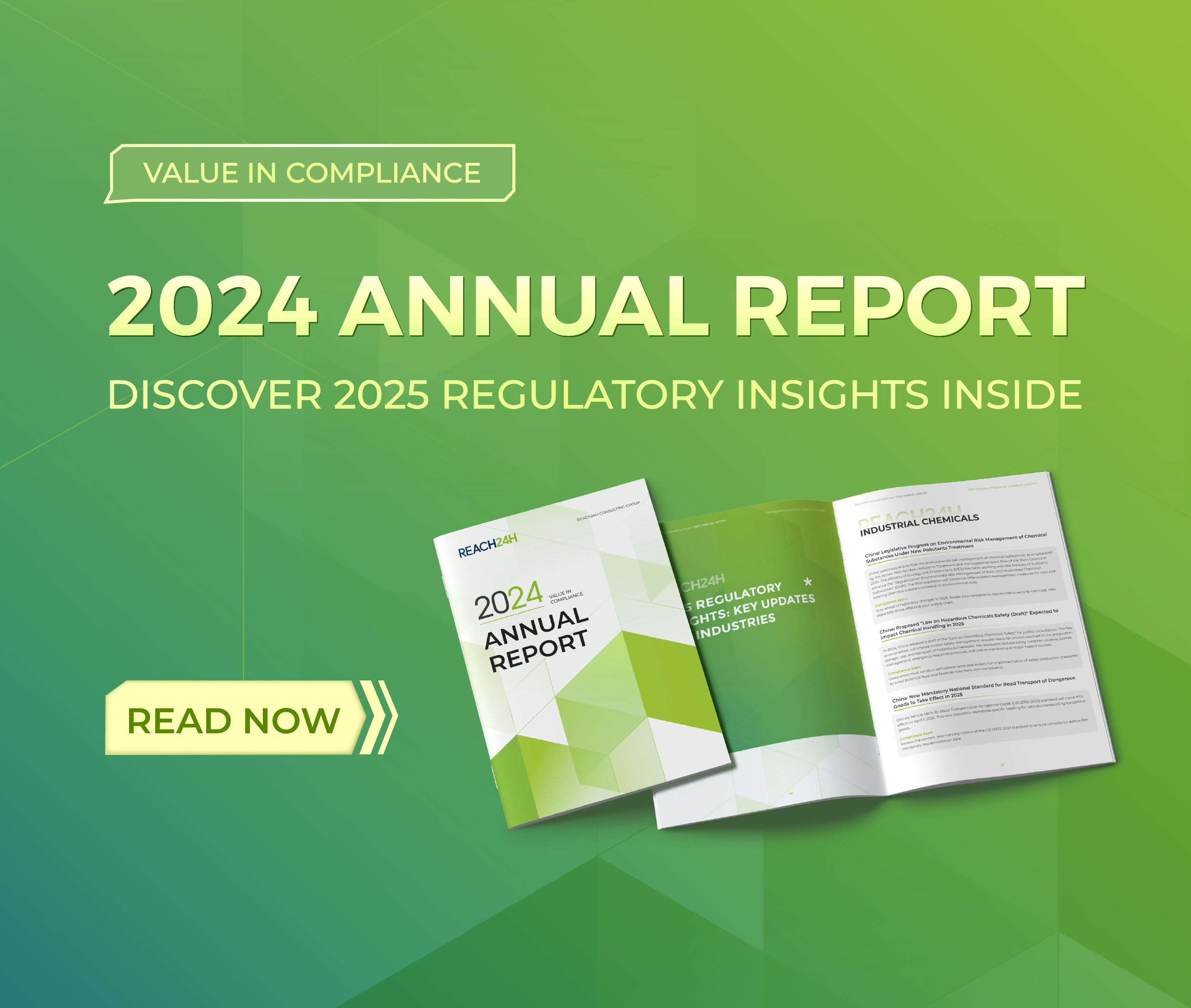China GHS Services
 In order to enhance the safety of human health and the environment, the GHS (Globally Harmonized System of Classification and Labeling of chemicals) was issued as a recommendation from the United Nations in 2003. The conception of GHS was adopted by many countries in the subsequent years, including China. Under the UN GHS framework, Chinese authorities promised to start the relevant introductory works in 2006 and implement GHS in the whole country by 2008. However, the real start of implementation of China GHS has been marked by the adoption of a regulation of landmark significance in existing chemicals management, Regulations on the Control over Safety of Hazardous Chemicals (or the State Council Decree No. 591), published on February 2011 and is to take effect on 1 December, 2011.
In order to enhance the safety of human health and the environment, the GHS (Globally Harmonized System of Classification and Labeling of chemicals) was issued as a recommendation from the United Nations in 2003. The conception of GHS was adopted by many countries in the subsequent years, including China. Under the UN GHS framework, Chinese authorities promised to start the relevant introductory works in 2006 and implement GHS in the whole country by 2008. However, the real start of implementation of China GHS has been marked by the adoption of a regulation of landmark significance in existing chemicals management, Regulations on the Control over Safety of Hazardous Chemicals (or the State Council Decree No. 591), published on February 2011 and is to take effect on 1 December, 2011.
Skip to in-depth reading of China GHS – Introduction, Updates and Technical Know-how
Basics of China GHS
1. What is China GHS about?
China GHS at present covers requirements on Classification, Labeling and Material Safety Data Sheet of hazardous chemicals in China.The system is aimed to strengthen the safety management of hazardous chemicals, prevent and reduce hazardous chemical accidents, guarantee the life and property safety of the general public, and protect the environment.”
2. Who are subject to China GHS?
The Decree 591 applies to all legal entities based in China that are engaged in the production/manufacture, storage, use, operation or transportation of hazardous chemicals.
3. What chemicals are subject to China GHS?
Chemicals that meet either of the 3 below requirements are subject to China GHS:
1) Chemicals listed in the Catalogue of Hazardous Chemicals (download the 02 English full list free of charge);
2) Chemicals that could be identified as hazardous based on hazard identification;
3) Chemicals of which the hazard classification could be identified according to the 26 GB standards and of which the hazard data have been acquired by the company.
4. How Should I know if my substance belongs to hazardous chemicals?
1) Enquiry on Inventory of Hazardous Chemicals
The upcoming new Inventory of Hazardous Chemicals, expected to be issued by the end of 2011, is said to have combined the old 2002 Catalogue of Hazardous Chemicals and Catalogue of Highly Toxic Chemicals (2002) and will include over 7,000 substances following the UN GHS-compliant classifications.
2) Other national inventories of hazardous chemicals
GB 12268-2005 Inventory of hazardous goods that was published in July 2005 and took effect since November 2005
The First Inventory of Hazardous Chemicals for Priority Management, issued by the State Administration of Work Safety this year, now contains 62 priority hazardous chemicals, adding 2 explosives to the June list.
5. What obligations should I fulfill under China GHS?
1) Preparing or updating China GHS-compliant classification and labeling
2) Compiling Material Safety Data Sheet: According to Decree No. 591, from 5 May, 2011 upward, manufacturers and importers of hazardous chemicals shall supply the GHS-compliant SDSs and attach corresponding labels to the packing (including outer package) for the hazardous chemicals produced or imported.
3) Registering the hazardous chemicals at SAWS-NRCC: Manufacturers and importers of hazardous chemicals in China shall register identified hazardous chemicals with the National Registration Center of Chemicals (NRCC) of State Administration of Work Safety (SAWS) prior to manufacture or importation for the first time.
In order to better regulate the work of hazardous chemicals registration, the nation has recently issued the revised draft of Measures for the Administration of Hazardous Chemicals Registration for public consult on October 11, 2011. The final Revised Measures are expected to be on public soon before the year’s end. Click here for detailed interpretation on this revised draft.
6. Why must I comply with China GHS?
The government needs to:
—prevent and reduce hazardous chemical accidents
—guarantee the life and property safety of the general public
—protect the environment
The industry needs to:
—unify the market of hazardous chemicals in terms of the classification, labeling and packaging of hazardous chemicals
— facilitate the process of hazard data communication along the supply chain
Enterprises need to:
—save on resources spent on the management of hazardous chemicals
—improve the management efficiency on hazardous chemicals
—maintain a lasting and sustainable corporate development for the shareholders
7. What will I gain from the compliance with China GHS?
More secured protection
More efficient operation mode
More responsible business image
8. What national standards should I get to know for China GHS?
Compulsory standards
Standard for Classification: General rules for classification and hazard communication of chemicals (GB 13690-2009), in replace of the previous GB 13690-1992
Published in 2009 and in effect since 1 May 2010, this standard revises the chemical hazard communications ruses and reclassifies chemical hazards in accordance with China GHS.
Standard for Labeling: General rules for the preparation of precautionary labeling for chemicals (GB 15258-2009), in replace of the previous GB 15258-1999
This standard defines terminology used in chemical labeling, the content of labels and other requirements on label preparation and use. The new version adds “label dimensions” to Article 5.3 and “Simplified labels” to Article 4.3. Examples of precautionary labels and its placement, transport symbols, and precautionary statements for different categories of chemicals are also included in the appendices.
Standard for Packaging: Packaging symbols for dangerous goods (GB 190-2009)
This standard details the classification logo, size, color, methods of use etc. of the packaging label of dangerous goods. It aims to implement the 15th revised edition of the UN recommendations on the Transport of Dangerous Goods.
26 GB standards for compiling safety rules for the specific physical hazards, health hazards and environmental hazard: Safety Rules for Classification, Precautionary Labeling and Precautionary Statements of Chemicals (GB 20576 – GB 20602)
The four national standards are all based on China’s 26 GHS standards. There are currently no Aspiration Hazards or Ozone Depletion hazards included in the standards. Some differences also exist in hazard categories and criteria between China GHS and UN GHS.
One recommended standard
For GHS SDS: Safety data sheet for chemical products – Content and order of sections (GB/T 16483-2008)
Published in 2008 and in effect since 2 February 2009, this standard gives guidance on structure, content and the general format of SDS reports under China GHS. However this standard does not provide a practical sample for SDS writing.
9. How should I begin deploying my China GHS plan?
Step 1: Determine if my substance belongs to a hazardous chemicals
Step 2: Study required national standards
Step 3: Carry on data gathering and data analysis
Step 4: Consults on necessary tests or other legislature/technical issues
Step 5: Set about to preparing or updating the required hazard classification, label, package design and most importantly GHS-compliant SDS.
Step 6: Maintenance of your hazard data on hand and establish your own system of safety control measures (with the help of professional regulatory agencies)
10. What can REACH24H do to help me comply with China GHS?
We provide you professional services on:
- Free GHS consultation
- Re-classification of substances and mixtures according to China GHS
- Preparation of label according to China GHS
- Preparation of China GHS – compliant SDS
- SDS Translation with specialized SDS software, guarantee quality and delivery
- Update your SDS authoring software, especially on China GHS
— Preparation of formats of SDS and label according to China GHS
— Providing Chinese national standard data sources for preparation of SDS
–Classification of China GHS
–Training of SDS and label making under China GHS
–Providing the latest Chinese national standards and relevant lists
–Review China SDS wording
–Consultation of implement of GHS in China and other countries
In-depth Information Go up to Basics of China GHS
1. Review the latest implementation progress of China GHS?
2. Main precautions to take notice of prior to my China GHS plan?
3. Technical key points to focus on during my China GHS preparation?
4. Learn interpretation on core national policies of China GHS?
5. Problems (technical or legislative) still to be solved to in the implementation of China GHS?
6. Leave your concerns or feedback to us on the implementation of China GHS?
Join us now and contribute to a more transparent, highly-efficient and sound chemical classification and label institute for China’s future chemical industry.
Contact us for more information or a quote to prepare your China GHS compliant labeling or Safety Data Sheets.


